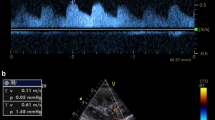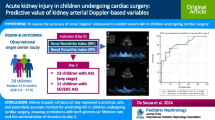Abstract
Background
Sepsis associated acute kidney injury (AKI) is linked with adverse outcomes in the PICU. Doppler-based renal resistive index (RRI) has shown promising results in adults for prediction of AKI. We aimed to explore the performance of RRI in children with sepsis.
Methods
This prospective observational study (March – November 2022) included children aged 1–12 years with sepsis admitted to the PICU. RRI and urine neutrophil gelatinase associated lipocalin (NGAL) were measured within 12 h of admission. Children were followed up for 3 days. AKI (new and persistent) was defined as any child with KDIGO stage 2 or 3 AKI on day 3.
Results
We enrolled 90 children but included 79 in final analysis. Two thirds (n = 53, 67%) had septic shock. Median (IQR) age was 6.2 years (4.1–9.2). RRI decreased with increasing age. Twenty-six (33%) children had AKI on day 3. Mean (SD) RRI was higher in the AKI group [0.72 (0.08) vs. 0.65 (0.07), p < 0.001].The area under ROC curve for RRI to detect AKI among the 1–4 year old group was 0.75 (95% CI:0.51, 0.98; p = 0.05) and among the 5–12 year old group was 0.76 (0.62, 0.89; p = 0.001). An RRI 0.71 predicted AKI with 100% sensitivity and 46.2% specificity among the 1–4-year-old group and RRI 0.69 predicted it with 70% sensitivity and 77.5% specificity in the 5–12-year-old group. RRI and eGFR at admission were independent predictors of AKI on multivariable analysis. Urine NGAL 94.8 ng/ml predicted AKI with 76.9% sensitivity and 77.4% specificity and AUROC was 0.74 (0.62, 0.86) among the 1–12-year-old group.
Conclusions
RRI values varied with age. RRI showed good diagnostic accuracy to detect new/persistent AKI on day 3 in children with sepsis; however, it was less precise as an independent predictor.
Graphical abstract

A higher resolution version of the Graphical abstract is available as Supplementary information


Similar content being viewed by others
Data availability
The data that support the findings of this study are available from the corresponding author (KN) upon reasonable request.
References
Kaddourah A, Basu RK, Bagshaw SM, Goldstein SL et al (2017) Epidemiology of acute kidney injury in critically ill children and young adults. N Engl J Med 376:11–20
Selewski DT, Cornell TT, Heung M, Troost JP, Ehrmann BJ, Lombel RM et al (2014) Validation of the KDIGO acute kidney injury criteria in a pediatric critical care population. Intensive Care Med 40:1481–1488
Fitzgerald JC, Basu RK, Akcan-Arikan A, Izquierdo LM, Pineres Olave BE, Hassinger AB et al (2016) Acute kidney injury in pediatric severe sepsis: an independent risk factor for death and new disability. Crit Care Med 44:2241–2250
Hall PS, Mitchell ED, Smith AF, Cairns DA, Messenger M, Hutchinson M et al (2018) The future of diagnostic tests of acute kidney injury in critical care: evidence synthesis, care pathway analysis and research prioritization. Health Technol Assess 22:1–274
Alobaidi R, Basu RK, Goldstein SL, Bagshaw SM (2015) Sepsis-associated acute kidney injury. Semin Nephrol 35:2–11
Starr MC, Banks R, Reeder RW, Fitzgerald JC, Pollack MM, Meert KL et al (2020) Severe acute kidney injury is associated with increased risk of death and new morbidity after pediatric septic shock. Pediatr Crit Care Med 21:e686–e695
Haitsma Mutlier JLG, Rozemeijier S, Roettgering JG, Spoelstra-de Man AME, Elbers PWG, Tuinman PR et al (2018) Renal resistive index as an early predictor and discriminator of acute kidney injury in critically ill patients; a prospective observational cohort study. PLoS One 13:e0197967. https://doi.org/10.1371/journal.pone.0197967
Goldstein B, Giroir B, Randolph A (2005) International Consensus Conference on Pediatric sepsis. International pediatric sepsis consensus conference: definitions for sepsis and organ dysfunction in pediatrics. Pediatr Crit Care Med 6:2–8. https://doi.org/10.1097/01.PCC.0000149131.72248.E6
Kidney Disease: Improving Global Outcomes (KDIGO) Acute Kidney Injury Work Group (2012) KDIGO clinical practice guidelines on acute kidney injury. Kidney Int Suppl 2:1–138
Basu RK, Hackbarth R, Gillespie S, Akcan Arikan A, Brophy P, Bagshaw S et al (2021) Clinical phenotypes of acute kidney injury are associated with unique outcomes in critically ill septic children. Pediatr Res 90:1031–1038
Vade A, Subbaiah P, Kalbhen CL, Ryva JC (1993) Renal resistive indices in children. J Ultrasound Med 12:655–658
Bude RO, DiPietro MA, Platt JF, Rubin JM, Miesowicz S, Lundquist C (1992) Age dependency of the renal resistive index in healthy children. Radiology 184:469–473
Kuzmic AC, Brkljacic B, Ivankovic D, Galesic K (2000) Doppler sonographic renal resistive index in healthy children. Eur Radiol 10:1644–1648. https://doi.org/10.1007/s003300000466
Sigirci A, Hallac T, Akyncy A, Temel I, Gulcan H, Aslan M, Kocer M, Kahraman B, Alkan A, Kutlu R (2006) Renal interlobar artery parameters with duplex doppler sonography and correlation with age, plasma renin and aldosterone levels in healthy children. AJR Am J Roentgenol 186:828–832
Post EH, Kellum JA, Bellomo R, Vincent JL (2017) Renal perfusion in sepsis: from macro- to microcirculation. Kidney Int 91:45–60. https://doi.org/10.1016/j.kint.2016.07.032
De Carvalho AV, Ferraz IS, de Souza FM, Brandao MD, Nogueira RJN, Alves DFS et al (2023) Acute kidney injury in critically ill children: predictive value of renal arterial Doppler assessment. Pediatr Res 93:1694–1700. https://doi.org/10.1038/s41390-022-02296-1
Sharkey RA, Mulloy EM, Long M, O’Neill SJ (1999) The effect of continuous positive airway pressure (CPAP) on renal vascular resistance: the influence of renal denervation. Crit Care 3:33–37
Fu Y, He C, Jia L, Ge C, Long L, Bai Y et al (2022) Performance of renal resistive index and usual clinical indicators in predicting persistent AKI. Ren Fail 44:2028–2038
Darmon M, Bourmaud A, Reynaud M, Rouleau S, Meziani F, Boivin A et al (2018) Performance of Doppler-based resistive index and semi-quantitative renal perfusion in predicting persistent AKI: results of a prospective multicenter study. Intensive Care Med 44:1904–1913
Tublin ME, Tessler FN, Murphy ME (1999) Correlation between renal vascular resistance, pulse pressure and the resistive index in isolated perfused rabbit kidneys. Radiology 213:258–264
Tanimura M, Dohi K, Matsuda M, Sato Y, Suigura E, Kumagai N et al (2015) Renal resistive index as an indicator of the presence and severity of anemia and its future development in patients with hypertension. BMC Nephrol 16:45
Sharkey RA, Mulloy EM, O’Neill SJ (1999) The acute effects of oxygen and carbon dioxide on renal vascular resistance in patients with an acute exacerbation of COPD. Chest 115:1588–1592
Ngai CW, Lam MF, Lo SH, Cheung CW, Chan WM (2011) Use of Doppler ultrasound renal resistive index and neutrophil gelatinase associated lipocalcin in prediction of acute kidney injury in patients with septic shock. Crit Care 15:P108
Dawood HF, Fouad HA, El-Shafei MM, Hussein HW, Razek AA (2022) Renal Resistive Index (RRI) Versus Urinary Neutrophil Gelatinase Associated Lipocalin (uNGAL) in adults undergoing elective cardiac surgeries with cardiopulmonary bypass: A prospective randomized observational study. Egypt J Anaesth 38:166–173
Bagshaw SM, Bennett M, Haase M, Haase-Fielitz A, Egi M, Morimatsu H et al (2010) Plasma and urine neutrophil gelatinase-associated lipocalin in septic versus non-septic acute kidney injury in critical illness. Intensive Care Med 36:452–461
Zhang A, Cai Y, Wang PF, Qu JN, Luo ZC, Chen XD et al (2016) Diagnosis and prognosis of neutrophil gelatinase-associated lipocalin for acute kidney injury with sepsis: a systematic review and meta-analysis. Crit Care 20:41
Kapalavai SK, Ramachandran B, Krupanandan R, Sadasivam K (2022) Usefulness of Urinary Neutrophil Gelatinase-associated Lipocalcin as a Predictor of Acute Kidney Injury in Critically Ill Children. Indian J Crit Care Med 26:634–638
Tornblom S, Nisula S, Petaja L et al (2020) Urine NGAL as a biomarker for septic AKI: a critical appraisal of clinical utility – data from the observational FINNAKI study. Ann Intensive Care 10:51
Martensson J, Bellomo R (2014) The Rise and Fall of NGAL in Acute Kidney Injury. Blood Purif 37:304–310
Funding
The Indian Council of Medical Research (ICMR) granted partial financial assistance [INR 50000] for this study as part of an award for the DM thesis during December 2021.
Author information
Authors and Affiliations
Corresponding author
Ethics declarations
Conflict of interest
The authors declare that there are no conflicts of interest.
Additional information
Publisher's Note
Springer Nature remains neutral with regard to jurisdictional claims in published maps and institutional affiliations.
Supplementary Information
Below is the link to the electronic supplementary material.
Rights and permissions
Springer Nature or its licensor (e.g. a society or other partner) holds exclusive rights to this article under a publishing agreement with the author(s) or other rightsholder(s); author self-archiving of the accepted manuscript version of this article is solely governed by the terms of such publishing agreement and applicable law.
About this article
Cite this article
Rajangam, M., Nallasamy, K., Bhatia, A. et al. Renal resistive index by point of care ultrasound to predict sepsis associated acute kidney injury in critically ill children. Pediatr Nephrol (2024). https://doi.org/10.1007/s00467-024-06392-8
Received:
Revised:
Accepted:
Published:
DOI: https://doi.org/10.1007/s00467-024-06392-8




